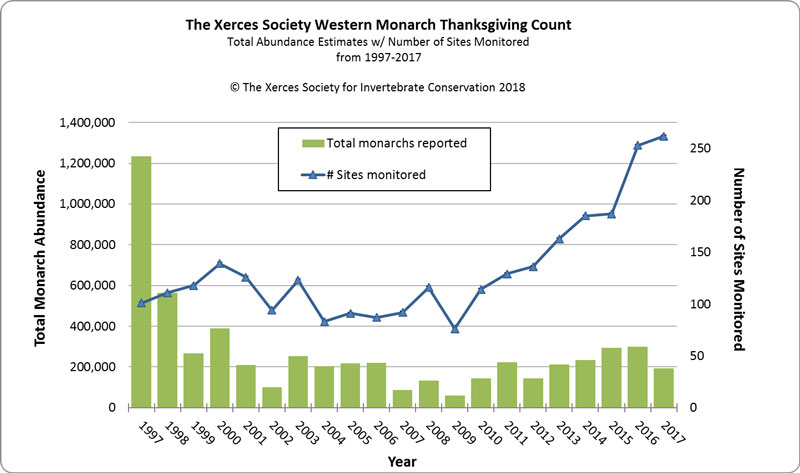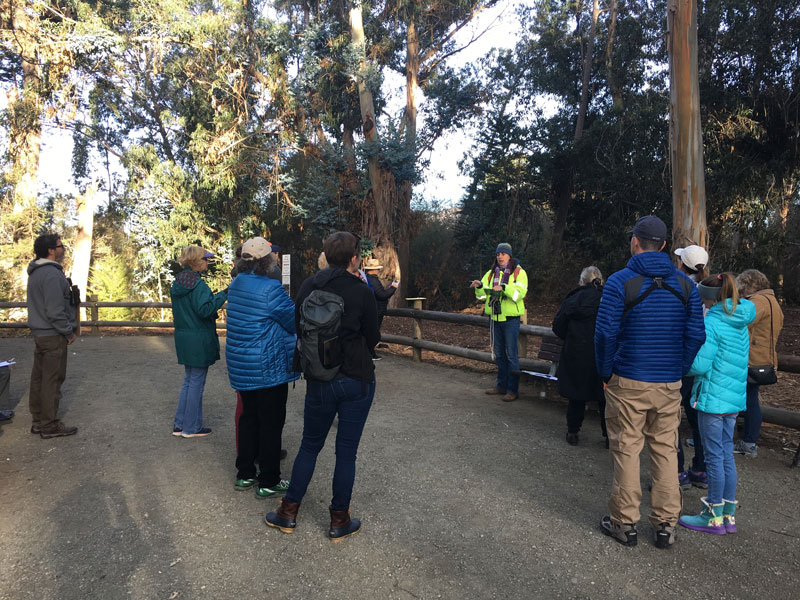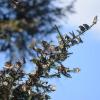The Western Monarch Thanksgiving Count (WMTC) tracks the population of monarch butterflies that overwinter along the Pacific Coast in California and Baja California. Started in 1997, WMTC is one of the longest-running insect monitoring projects in the country. Continuing the tradition, this year, more than 150 enthusiastic volunteers spread out along the coast to find and count monarchs. Over the past few years, the number of sites covered has swelled thanks to the remarkable regional coordinators who dedicate much time to organizing activities, training volunteers, and of course, counting monarchs. Mia Monroe, one of the WMTC’s founders, has been organizing and inspiring others for over 20 years. Other current (and past) regional coordinators that serve as local experts and invaluable resources for volunteers include Bill Shepard, Christina Garcia, Martha Nitzberg, Nick Stong, Jessica Griffiths, Charis van der Heide, Rick Hansen, Saul Riatiga, and Rachel Williams.
Thanks to the efforts of many, this year’s WMTC tallied a total of 192,629 monarchs. This is the lowest number counted since 2012, despite volunteers visiting nearly twice as many sites as they did that year. The total represents less than one-sixth of the 1.2 million monarchs recorded in 1997, the first year of the WMTC, and is part of a long-term downward trend in the population of monarchs overwintering in California. A study led by Cheryl Schultz, of Washington State University Vancouver, analyzed WMTC data and comparable historical data and demonstrated a dramatic population decline of over 95% the since the 1980s. This is similar to the decline of over 80% seen in the monarch population that overwinters in central Mexico since the 1990s.

Fall of 2017 seems to have been a very unusual year for overwintering monarchs. We have had many reports of unseasonably warm temperatures, late season mating, and late occurrence of eggs and caterpillars. We do not yet know how the wildfires and associated smoke in many parts of California affected migrating or late breeding monarchs, nor whether the drenching rain and devastating mudslides that occurred soon after had an impact. It is difficult to know if the overwintering population experienced as sharp a decline as the WMTC numbers suggest or if it was partly that the butterflies were simply late clustering in this late, warm fall (which may be increasingly common with climate change).
Even though the counts are low, we should celebrate the massive volunteer effort. This year the Xerces Society, regional coordinators, and the U.S. Fish and Wildlife Service hosted multiple training workshops to engage new volunteers throughout the state. The result was that a record number of people participated this year and there was better coverage of the southern California sites. We also had higher volunteer participation in the second annual New Year’s Count compared to last year (results forthcoming in late-February).

The success of the WMTC is only possible thanks to these many volunteers and hard-working regional coordinators, including new coordinator Saul Riatiga—who is surveying in Baja, Mexico—and Rachel Williams—who led volunteers on backpacking trips to survey the small inland sites of Inyo County. Both areas were historically known to host overwintering monarchs, but have not been officially counted by volunteers as part of the WMTC for a decade or more. This year, both areas reported monarchs, although in small numbers.
The long-term data set gathered over successive counts is an immensely valuable resource that enables researchers and conservationists to address the crisis facing monarchs with accurate information about the butterfly’s population. This is rare for most invertebrate species and it reflects the forethought and concern of the WMTC’s founders. With this information, we can collectively act to protect and conserve monarchs and their habitat by addressing the many threats that monarchs face—from pesticide use and habitat loss to climate change and disease. With the continuation of engaged volunteers, public support, and policy, we will continue to raise awareness and further assist monarchs on their recovery.
Resources
To learn more about the Western Monarch Thanksgiving Count, visit: www.westernmonarchcount.org.
To report sightings of non-overwintering monarchs and milkweed in the western states, visit: www.monarchmilkweedmapper.org.



